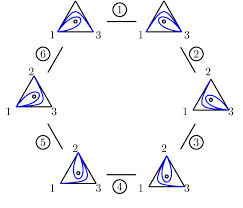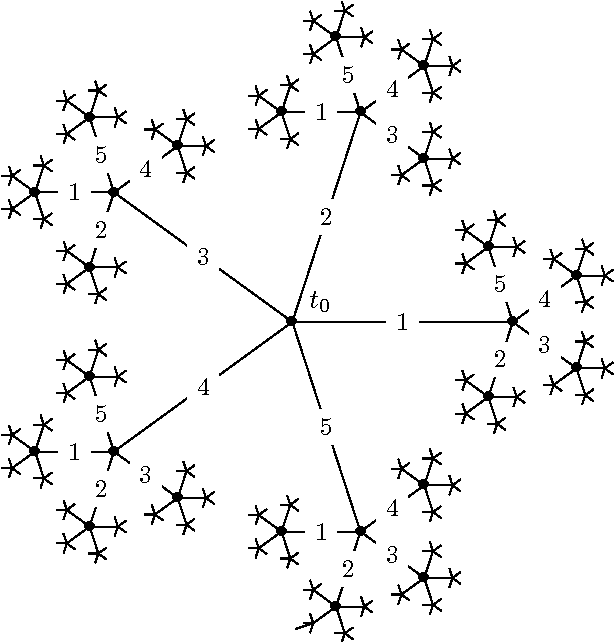


Geometry and Topology Seminar
Fall 2021 Semester Talks
- Wednesday, September 15, 2021
- Burns Healey, University of Wisconsin, Milwaukee
- Title:Higher Rank Extensions of Nilpotent Lie Groups
- Abstract:
Heintze groups are one-dimensional extensions of nilpotent Lie groups that admit Riemannian metrics of negative curvature. It is well known that these spaces only admit proper and cocompact actions by discrete groups when they are symmetric spaces. We define a higher rank analog of these Lie groups and discuss some of the geometric properties of their Riemannian metrics, including when they admit geometric (quasi-)actions by discrete groups.
- Thursday, September 23, 2021
- Benjamin Ward, Bowling Green State University
- Title: A generalization of Out(F_n) and higher assembly operations.
- Abstract:
First we will recall work of Conant-Kassabov-Hatcher-Vogtmann who introduced a family of groups generalizing Out(F_n) and partially computed their homologies. This family of groups is of interest because homology classes can be assembled to form classes in the homology of Out(F_n). We then introduce a higher homotopical assembly operation and, time permitting, explain how it may be used to give a new model for commutative graph homology.
- Wednesday, October 13, 2021
- Arman Darbinyan, Texas A&M University
- Title: Embeddings into left-orderable simple groups.
- Abstract:
Topologically speaking, left-orderable countable groups are precisely
those countable groups that embed into the group of orientation
preserving homeomorphisms of the real line. A recent advancement in the
theory of left-orderable groups is the discovery of finitely generated
left-orderable simple groups by Hyde and Lodha. We will discuss a
construction showing that every countable
left-orderable group is a subgroup of such a group. We will also discuss
some of the algebraic, geometric, and computability properties that this
construction bears. The construction is based on novel topological and
geometric methods that also will be discussed. The flexibility of the
embedding method allows us to go beyond the class of left-orderable
groups as well. Based on a joint work with Markus Steenbock.
- Thursday, October 21, 2021
- Michael Roysdon, Tel Aviv University
- Title: On Measure Theoretic Projection Bodies
- Wednesday, October 27, 2021 10:40 AM
- Alan McLeay, University of Luxembourg
- Title: Homeomorphic subsurfaces and omnipresent arcs
- Abstract:
Essential simple arcs are ubiquitous in the study of surfaces. Up to homeomorphism, there are only finitely many types of arc on any given finite-type surface. For a surface of infinite-type, the picture is more complicated. This talk will shine a light on parts of this picture; we observe which essential arcs are more essential than others. We then arrive at, and study, a natural arc graph for infinite-type surfaces, and a well behaved (very large) subset of surfaces.
- Thursday, November 4, 2021 4:00 PM EST
- Michelle Chu, University of Illinois, Chicago
- Title: Virtual properties of hyperbolic 3-manifolds
- Abstract: A virtual property of a 3-manifold is a property satisfied by a finite cover of the 3-manifold. The study of such properties has been at the heart of several major developments in 3-manifold topology in the past decade. In this talk I will provide motivation and background on these virtual properties and discuss some recent results.
- Wednesday, November 10, 2021 10:30 AM EST
- Nataliya Balabanova, University of Toledo
- Title: Point vortices on non-orientable manifolds
- Abstract: Hamiltonian approach to the dynamics of point vortices on a surface involves the symplectic form on the surface together with the vorticity of the point vortices. On the other hand, nothing prevents us from considering systems of point vortices on non- orientable manifolds; however, most elements from the classical Hamiltonian approach involve the choice of orientation. In this talk we will discuss the setup for considering point vortices on non- orientable manifolds, with particular emphasis on the case of the Möbius band. This is joint work with Dr. James Montaldi.
- Thursday, November 18, 2021 4:00 PM EST
- Rylee Lyman, Rutgers University
- Title: Train track maps and CTs on graphs of groups
- Abstract: A homotopy equivalence of a graph is a train track map when it sends vertices to vertices and the restriction of any iterate of the map to an edge yields an immersion. (Relative) train track maps were introduced by Bestvina and Handel in 1992; since then they have become one of the main tools in the study of outer automorphisms of free groups. More recently in 2011, Feighn and Handel introduced a stronger kind of relative train track map called a CT and proved their existence for all outer automorphisms after passing to a power. We extend the theory of relative train track maps to graphs of groups with finitely generated, co-Hopfian edge groups and the theory of CTs to free products (that is, graphs of groups with trivial edge groups).
- Thursday, December 2, 2021 4:00 PM EST
- Yu-Chan Chang, Emory University
- Title: Dehn Functions and Abelian Splittings of Bestvina--Brady Groups
- Abstract: The Dehn function of a finitely presented group gives an upper bound of the complexity of the word problem on that group. It has been shown that the Bestvina--Brady groups have at most quartic Dehn functions. In the first part of the talk, I will discuss a family of Bestvina--Brady groups whose Dehn functions can be identified from the defining graphs. One of the cases within our discussion is when Bestvina--Brady groups split over $\mathbb{Z}$. In the second part of the talk, I will talk about abelian splittings of Bestvina--Brady groups and some applications.
Spring 2022 Semester Talks
- Monday, February 7, 2022 10:00 AM EST
- Abdul Zalloum, Queen's University
- Title: Hyperplanes beyond CAT(0) cube complexes
- Abstract: (Joint with Petyt and Spriano) A revolutionary work of Sageev shows that the entire structure of a CAT(0) cube complex is encoded in the combinatorics of its hyperplanes. I will describe a very natural way in which hyperplanes arise beyond the world of CAT(0) cube complexes including CAT(0) spaces/groups, mapping class groups, and coarse median spaces that satisfy an extra condition. Using such hyperplanes, we build a family of hyperbolic models in the same fashion the contact graph of Hagen and the separation graph of Genevious are built. For instance, in the mapping class group case, the hyperbolic models we build coincides (up to quasi-isometry) with the curve graph, and in RAAGS, they coincide with the contact graph of Hagen. A great deal of the well-known theorems regarding actions on such graphs almost effortlessly carry through from the world of cubulated groups to the class of groups where such hyperplanes exist. The main new class of groups our work provides hyperbolic models for is the class of CAT(0) groups.
- Heejoung Kim, Ohio State University. March 14, MONDAY 10:00-11:00 AM
- Thursday, March 24, 2022 4:00 PM EST
- Jingyin Huang, Ohio State University
- Title: Morse quasiflats
- Abstract:
We are motivated by looking for traces of hyperbolicity in a space or group which is not Gromov-hyperbolic. One previous approach in this direction is the notion of Morse quasigeodesics, which describes "negatively-curved" directions in the spaces; another previous approach is "higher rank hyperbolicity" with one example being that though triangles in products of two hyperbolic planes are not thin, tetrahedrons made of minimal surfaces are "thin". We introduce the notion of Morse quasiflats, which unifies these two seemingly different approaches and applies to a wider range of objects. In the talk, we will provide motivations and examples for Morse quasiflats, as well as a number of equivalent definitions and quasi-isometric invariance (under mild assumptions). We will also show that Morse quasiflats are asymptotically conical, and comment on potential applications. Based on joint work with B. Kleiner and S. Stadler.
- Yining Zhang, University of Colorado. March 31, THURSDAY 4:00-5:00 PM.
- Wenyuang Yang, Beijing University. April 11 MONDAY 10:00-11:00 AM
- Sophie Raynor, James Cook University, Australia April 21
- Tom Ferragut. University of Montpellier, April 25 MONDAY 10:00-11:00 AM
Fall 2022 Semester Talks:
- Thursday, September 9, 2022 4:00 PM EST
- Ignat Soroko, University of North Texas
- Title: Divergence in Coxeter groups
- Abstract:
Divergence of a metric space is an interesting quasi-isometry invariant of the space which measures how geodesic rays diverge outside of a ball of radius r, as a function of r. Divergence of a finitely generated group is defined as the divergence of its Cayley graph. For symmetric spaces of non-compact type the divergence is either linear or exponential, and Gromov suggested that the same dichotomy should hold in a much larger class of non-positively curved CAT(0) spaces. However this turned out not to be the case and we now know that the spectrum of possible divergence functions on groups is very rich. In a joint project with Pallavi Dani, Yusra Naqvi, and Anne Thomas, we initiate the study of the divergence in the general Coxeter groups. We introduce a combinatorial invariant called the `hypergraph index', which is computable from the Coxeter graph of the group, and use it to characterize when a Coxeter group has linear, quadratic or exponential divergence, and also when its divergence is bounded above by a polynomial.
- Thursday, September 15, 2022 4:00 PM EST
- Yandi Wu, University of Wisconsin Madison.
- Title: A topologically rigid set of quotients of the Davis complex
- Abstract:
A class of topological spaces is topologically rigid if for any pair of spaces in the class, an isomorphism on the level of fundamental groups induces a homeomorphism. One famous example of a topologically rigid class is the set of simply connected 3-manifolds (Poincare’s conjecture). In this talk, we examine a set of K(G,1) spaces of certain right-angled Coxeter groups (RACGs), which is not a topologically rigid class. However, if we impose certain restrictions on the defining graphs of the RACGs, we can obtain an infinite topologically rigid subclass.
- Thursday, October 6, 2022 4:00 PM EST
- Samuel Shepherd, Vanderbilt University.
- Title: Commensurability of lattices in right-angled buildings
- Abstract:
Given compact length spaces $X_1$ and $X_2$ with a common universal cover, it is natural to ask whether $X_1$ and $X_2$ have a common finite cover. In particular, are there properties of $X_1$ and $X_2$, or of their fundamental groups, that guarantee the existence of a common finite cover? We will discuss several examples, as well as my new result which concerns the case where the common universal cover is a right-angled building. Examples of right-angled buildings include products of trees and Davis complexes of right-angled Coxeter groups. My new result will be stated in terms of weak commensurability of lattices in the automorphism group of the building.
- Thursday, October 20, 2022 4:00 PM EST
- Eduard Einstein, Swarthmore College.
- Title: Relative Cubulation of Small Cancellation Quotients
- Abstract:
Daniel Groves and I introduced relatively geometric actions, a new kind of action of a relatively hyperbolic group on a CAT(0) cube complex. Building on results of Martin and Steenbock for properly and cocompactly cubulated groups, Thomas Ng and I proved that C’(1/6)--small cancellation free products of relatively cubulable groups are relatively cubulable. The flexibility of relatively geometric actions allowed us to prove that C’(1/6)--small cancellation free products of residually finite groups are residually finite – without any need to assume that the factors are cubulable. In this talk, I will discuss techniques used to produce relatively geometric cubulations, applications to small cancellation quotients and potential future applications to random groups and small cancellation quotients of relatively hyperbolic groups.


